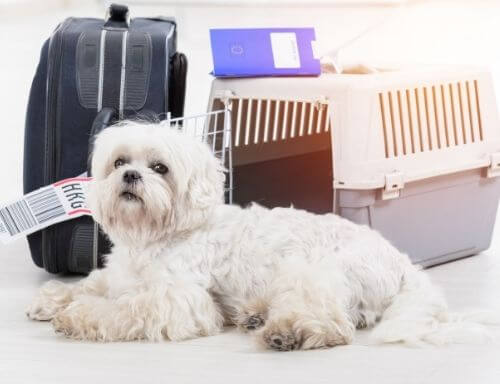Table of Contents
- 1 Mental Health: Bringing Your Pet to Canada and More
- 1.1 Contact Your Airline Ahead and Plan
- 1.2 Travel in Hot Weather
- 1.3 Bringing Pet Food
- 1.4 Is Quarantine Necessary?
- 1.5 Can You Bring Your Bunny?
- 1.6 What Are Some Recommendations For Travel With A Pet?
- 1.7 Mental Health: Calming the Human After Traveling to Your New Home
- 1.8 Think Positively and With Gratitude
Mental Health: Bringing Your Pet to Canada and More
Do you have some important questions about bringing your pet into our country? If you don’t want to leave your pet behind when migrating to Canada, it is possible to bring them with you. You will have to follow certain steps when bringing your furry friend to their new home. Life in your new country will be a bit smoother if your favorite animal companion is with you.
Whether your favorite pet is furry or smooth, there are different requirements for different types of animals. Be sure that you know them ahead of your move to Canada. Another consideration might be if your pet is traveling to another country first. There may be country-specific regulations.
In the case that you do not have a pet for support or do not intend to get one once here, there are some mental health tips at the end of this article which might make adjusting to Canada easier, without a furry friend.
Contact Your Airline Ahead and Plan
Each airline has different rules, so far ahead of time, contact your airline to find out the guidelines for bringing your pet on the flight. You should also have a carrier in which your pet can lie down, turn around and stand. The International Air Transport Association (IATA) can help you with guidelines on the sizes and suitability of containers for animals. You can only bring small dogs and cats within the cabin, if allowed.
If your airline does not allow pets in the cabin, they might be treated as special baggage and be put in a heated and ventilated holding area, which is quiet. They will be resting in a darkened environment, away from the noise and activity of the cabin.

Travel in Hot Weather
If you have a dog that is among the breeds that is sensitive to the heat, it is not recommended having them travel. These breeds include snub nose dogs, such as bulldogs, pugs, boxers and Pekingese. They have problems keep their normal body temperature during hot weather.
If you have another breed of dog, on long trips be sure that the animal has enough food and water for the trip, as required.
Bringing Pet Food
If you are bringing pet food into Canada, it must be a sealed bag that is unopened. It must be commercially packaged and from the United States. The maximum amount of food allowed is 44 pounds.
The animal that is eating the food must be with you at all times. Pet food imported into Canada is only for the pet accompanying you. Pet treats are also regulated.

Is Quarantine Necessary?
Quarantine for your pet may be required if you have not complied with vaccination rules. You should also have the paperwork to prove it; make sure to bring it.
Before you travel with a pet, make sure they are in good shape. A visit to the vet and necessary vaccinations may be in order before travel.
Can You Bring Your Bunny?
Yes, you can bring your bunny. You will need a permit at least 30 days in advance from the Canadian Food Inspection Agency (CFIA) and sign a paper that states that the rabbit is a pet of your own and that you will personally accompany the pet from the country of origin to Canada. There is a possibility that the rabbit may be quarantined for a small amount of time.
What Are Some Recommendations For Travel With A Pet?
When getting ready to travel to Canada, you may want to expose your pet to its crates in the weeks or months before your departure. Let it get used to it. The fact that the animal is leaving his known surroundings will be stressful in itself. Getting accustomed to the carrier or crate will be an important step in providing a comfortable trip for your pet.
Reduce the amount of food the day before, but still give it enough water. Walk your dog before going to the airport and again before check-in. Give it a light meal before putting the animal in the carrier; this is a legal requirement in the U.S.
Your pet must be properly identified. On the collar, affix the following two items:
- Permanent ID with your name and home address and telephone number
- Temporary travel ID with telephone number and address where you or a contact person can be reached
The use of tranquilizers and sedatives for travel is discouraged by IATA. This refers to pets that are traveling as cabin passengers as well as cargo. The reason behind this is that there is a potential for adverse effects during the transport. The American Veterinary Association endorses this view as well. These calming drugs may make it more difficult to reposition themselves and put them at risk for greater injury. Animals who have been taking these drugs regularly before travel will still have their benefits, even when not given before their trip to Canada. Your can learn more about it here.
Mental Health: Calming the Human After Traveling to Your New Home
You’ve moved to Canada and are now feeling stress adjusting to your new home. What can you do if you don’t have a pet companion to smooth things over? Here are some tips for taking care of yourself after travel as well as during other periods of stress.
You might want to take breaks from social media and the news. You can still be informed about what is going on in the world.You may have to practice social distancing but can still be connected by the following:
- Vido chats
- Phone calls
- And (possibly) social media
You can practice mindfulness and yoga. Stretch, take deep breaths and meditate. Eating healthy meals will make reducing stress easier. If you are not a gym member yet, get exercise by walking and exploring your new neighborhood or going to a park or out to the countryside. Regular exercise will lessen stress.
Remember to get plenty of sleep, as this will help your mind as well as immune system. Limit your use of substances, as they may add other problems.
Think Positively and With Gratitude
There will be challenges in your new home. Flexibility is a trait that will be of great help. Focus on the things that you can control in your life and all the positive aspects.
Be compassionate and kind to others as well as yourself.
If you are feeling overwhelmed, there are resources available to you, even to newcomers, seniors, parents and others. Your province or territory may have abundant programs that will be of help as well as places where you can meet others.
Whether you have family here or not, in addition having a pet companion, there is much support for the new arrival in Canada. That support might range from social clubs from your former country to mental health support for those with PTSD. Even if you have come from a traumatic situation, once in Canada, you can find support. Being in a new country might require making new friends as well as exploring new places. If your family is not here, you will be building a support system right from the time that you arrive in Canada. The road to becoming a permanent resident and citizen has help along the way.
Now you know what is needed when traveling to your new home in Canada with your furry friend. In fact, when considering whether to bring an animal into Canada, you’ll want to be sure your own immigration status is correct and in order. Additionally, you may want to find out more about Canadian spouse sponsorship or your parents immigration to Canada. As Licensed Canadian Immigration Consultants, we can provide information regarding residency, citizenship and much more. Contact us to have your human immigration questions answered.
